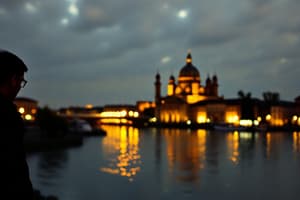Podcast
Questions and Answers
What is the primary focus of documentary photography?
What is the primary focus of documentary photography?
- Providing visual context to news stories
- Chronicling noteworthy events or social issues over time (correct)
- Capturing live sports events
- Documenting war or conflict situations
Which principle emphasizes the need to maintain multiple perspectives in photojournalism?
Which principle emphasizes the need to maintain multiple perspectives in photojournalism?
- Ethical Standards
- Objectivity (correct)
- Truthfulness
- Timeliness
What major impact has digital photography had on photojournalism?
What major impact has digital photography had on photojournalism?
- It has limited the use of traditional cameras.
- It has made capturing and sharing images faster and more accessible. (correct)
- It has eliminated the need for ethical standards.
- It has reduced the importance of composition.
Which of the following is a challenge faced by photojournalists?
Which of the following is a challenge faced by photojournalists?
What is a key characteristic of conflict photography?
What is a key characteristic of conflict photography?
What role do ethical standards play in photojournalism?
What role do ethical standards play in photojournalism?
Which famous photojournalist is best known for their work during the Great Depression?
Which famous photojournalist is best known for their work during the Great Depression?
In photojournalism, what does timeliness refer to?
In photojournalism, what does timeliness refer to?
Flashcards are hidden until you start studying
Study Notes
Photos and Photojournalism
Definition of Photojournalism
- A visual journalism form that uses photography to tell news stories.
- Combines the art of photography with the principles of journalism.
Importance of Photojournalism
- Captures real-life events and makes them accessible to the public.
- Provides visual context to news stories, enhancing understanding and emotional impact.
- Acts as a historical record of events.
Key Principles
- Truthfulness: Represents reality without manipulation or deception.
- Objectivity: Strives to balance viewpoints and present multiple perspectives.
- Ethical Standards: Adheres to guidelines regarding respect for subjects, especially in sensitive situations.
- Timeliness: Aims to deliver images promptly in relation to events.
Types of Photojournalism
- Documentary Photography: Focuses on chronicling noteworthy events or social issues over time.
- Sports Photography: Captures live sports events, focusing on action and emotion.
- Conflict Photography: Documents war or conflict situations, often highlighting human suffering.
Tools and Techniques
- Cameras: Range from DSLRs to mobile cameras; choice depends on the situation.
- Editing Software: Used for post-processing images while maintaining authenticity.
- Composition: Strong emphasis on framing, lighting, and angles to enhance storytelling.
Challenges in Photojournalism
- Ethical Dilemmas: Balancing sensationalism and respect for subjects.
- Safety Risks: Photographers often work in dangerous environments.
- Changing Industry: The rise of digital media and social platforms has reshaped traditional photojournalism.
Impact of Technology
- Digital Photography: Made capturing and sharing images faster and more accessible.
- Social Media: Platforms serve as immediate distribution channels for photojournalism.
- Drone Photography: Offers new perspectives and can capture hard-to-access areas.
Famous Photojournalists
- Dorothea Lange: Known for her work during the Great Depression.
- Robert Capa: Renowned for his war photography, especially during WWII.
- Steve McCurry: Famous for his portrait of the Afghan Girl.
Conclusion
- Photojournalism plays a vital role in informing and engaging the public.
- The combination of visual storytelling and journalistic integrity is essential for a functioning democracy.
Photojournalism Definition
- Photojournalism merges photography and journalism, creating a visual way to tell news stories.
Importance of Photojournalism
- Makes current events understandable and accessible through images.
- Adds emotional depth to news stories by providing a visual context.
- Creates a visual history of events.
Key Principles
- Truthfulness: Presents reality without alteration or deceit.
- Objectivity: Seeks to present multiple perspectives fairly.
- Ethical Standards: Adhering to respect and professionalism, especially in sensitive situations.
- Timeliness: Aiming to deliver images swiftly in relation to news events.
Types of Photojournalism
- Documentary Photography: Focuses on long-term documentation of significant events or social issues.
- Sports Photography: Captures live sports events, emphasizing action and emotion.
- Conflict Photography: Documents war or conflict situations, often highlighting the human impact.
Tools and Techniques
- Cameras: From professional DSLRs to mobile devices, chosen based on specific needs.
- Editing Software: Used for post-processing images while maintaining authenticity.
- Composition: Emphasizes framing, lighting, and angles to enhance storytelling.
Challenges in Photojournalism
- Ethical Dilemmas: Balancing impactful imagery with respect for subjects.
- Safety Risks: Photographers often work in dangerous environments.
- Changing Industry: The rise of digital media and social platforms is reshaping traditional photojournalism.
Impact of Technology
- Digital Photography: Enables faster image capture and dissemination.
- Social Media: Platforms provide immediate channels for photojournalism distribution.
- Drone Photography: Offers new perspectives and access to hard-to-reach areas.
Famous Photojournalists
- Dorothea Lange: Known for her work documenting the Great Depression.
- Robert Capa: Renowned for his war photography, particularly during WWII.
- Steve McCurry: Famous for his portrait of the Afghan Girl.
Conclusion
- Photojournalism is crucial for informing and engaging the public.
- The combination of visual storytelling and journalistic integrity is vital for a functioning democracy.
Studying That Suits You
Use AI to generate personalized quizzes and flashcards to suit your learning preferences.




